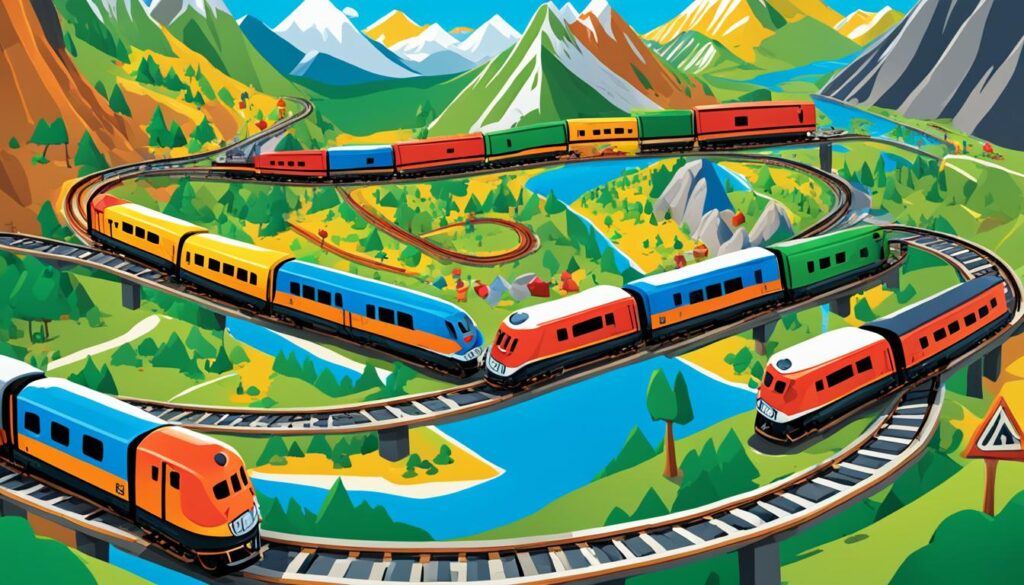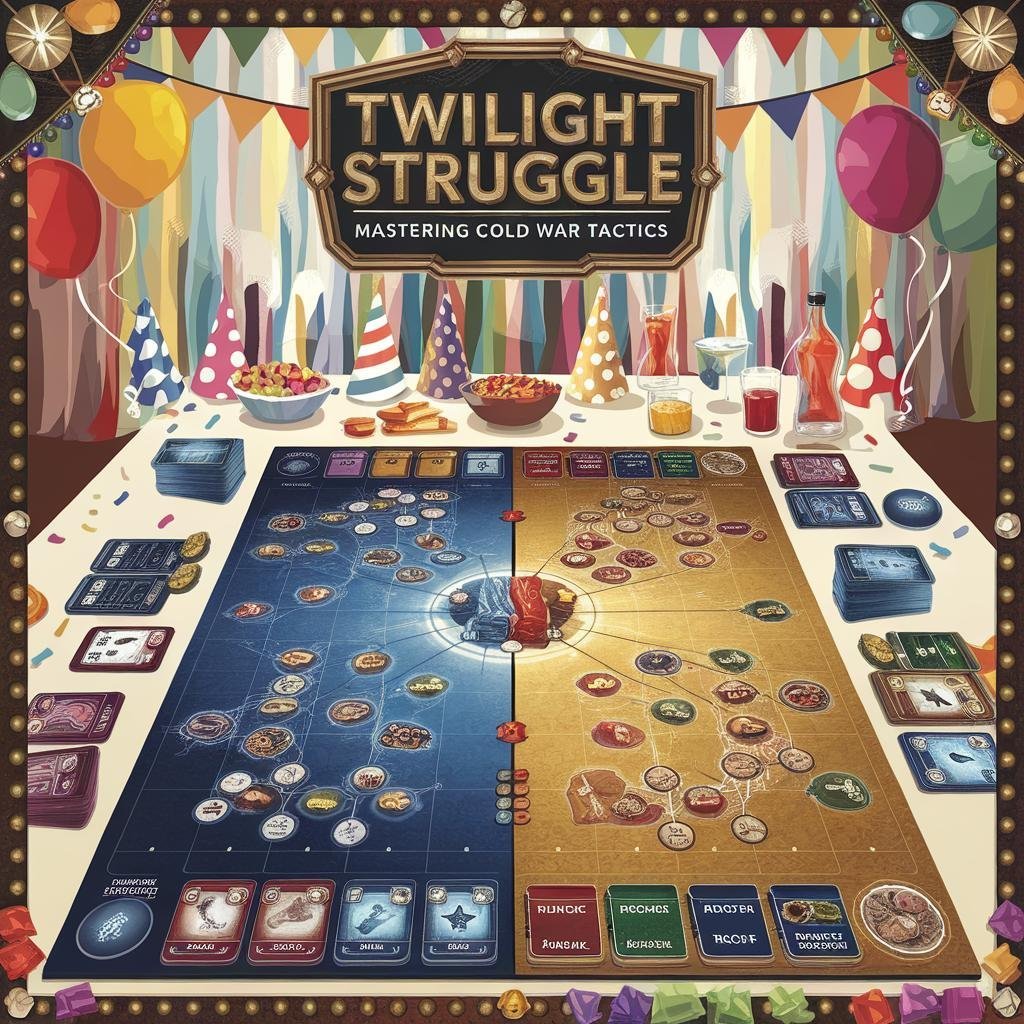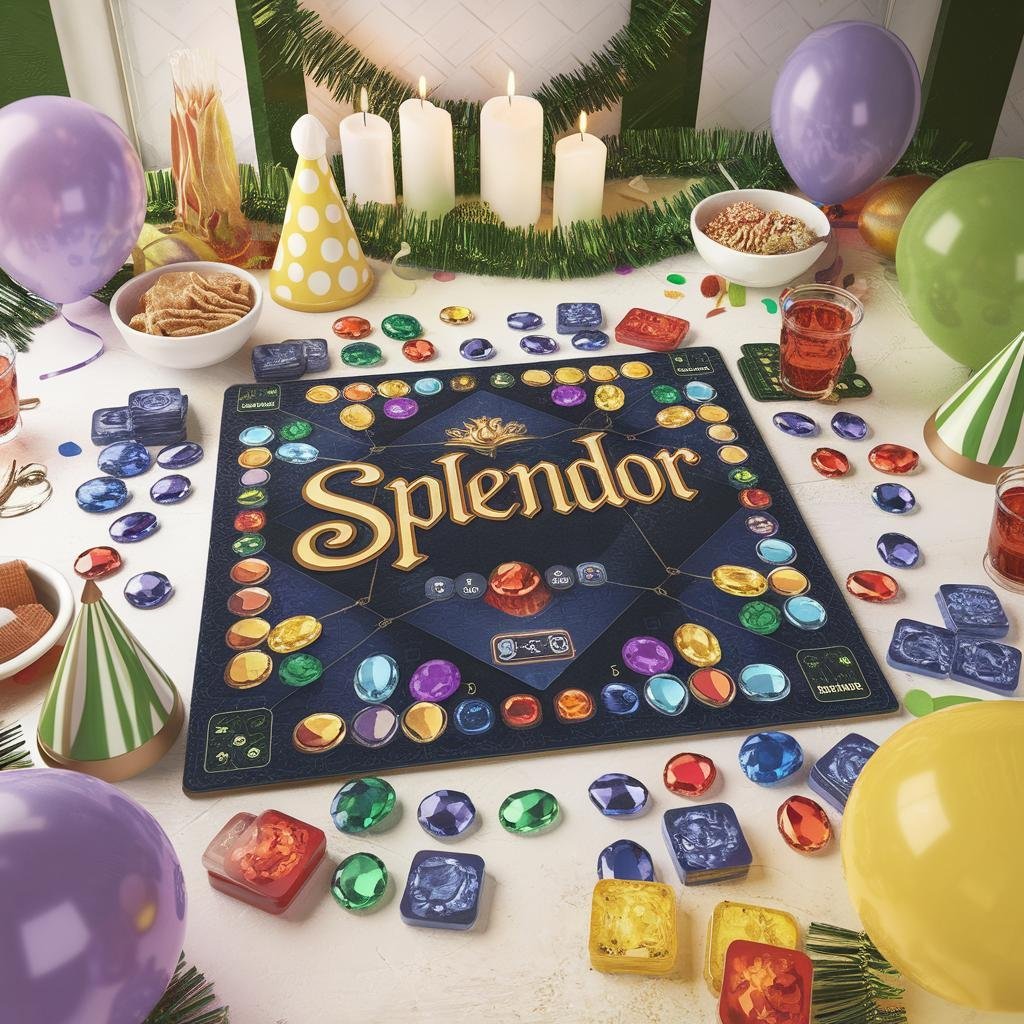Disclosure: This Post Contains Affiliate Links; We earn a commission on purchases.
Welcome to our guide on the best strategies for winning the popular board game Ticket to Ride. In this article, we will explore the key tactics that can help you secure victory in this exciting game of railway building and strategy. Whether you’re a seasoned player looking to refine your skills or a newcomer eager to learn the ropes, we’ve got you covered with expert advice and proven strategies.
Key Takeaways:
- Plan your routes strategically, prioritizing longer coast-to-coast routes for greater control and more points.
- Consider placing trains early to claim vital routes and prevent your opponents from blocking your routes.
- Control information by observing your opponents’ moves and discreetly gathering insights.
- Explore alternative strategies such as focusing on completing shorter routes quickly or solely collecting and completing long routes.
- Familiarize yourself with high-point routes and high-value destination tickets to maximize your scoring potential.
By implementing these winning strategies, you’ll be well on your way to dominating the tracks in Ticket to Ride. Remember to adapt your approach based on the number of players and adjust your strategy as the game unfolds. Get ready to embark on an exhilarating journey to victory!
Table of Contents
Planning Your Routes
One of the key decisions in Ticket to Ride is choosing which tickets to keep at the start of the game. It is recommended to prioritize longer, coast-to-coast routes as they offer more points and allow for greater control of the board. Effective Ticket to Ride strategies involve identifying the major cities on the map and planning your routes accordingly.
When selecting tickets, consider the following:
- Look for coast-to-coast routes that span the map, such as New York to Los Angeles or Seattle to Miami. These longer routes offer more points and can contribute to securing victory.
- Identify smaller destination tickets that share routes with your main route. By doing so, you can reduce the number of routes you need to capture and make completing tickets easier.
By focusing on longer routes and strategically selecting tickets, you can develop expert Ticket to Ride strategies that optimize your score and increase your chances of winning the game.
Sample Route Planning Strategy
Let’s consider a game of Ticket to Ride set in the United States. As an example, imagine that you start with the following destination tickets:
| Ticket | Route | Points |
|---|---|---|
| New York to Miami | New York – Washington – Raleigh – Charleston – Miami | 20 |
| Seattle to Los Angeles | Seattle – Portland – San Francisco – Los Angeles | 22 |
In this scenario, it is clear that the Seattle to Los Angeles route offers more points. Therefore, it would be wise to focus on connecting the cities along this route first.
To reduce the number of routes needed to complete these tickets, look for additional tickets that share routes with the main one. For example:
| Ticket | Route | Points |
|---|---|---|
| San Francisco to Atlanta | San Francisco – Salt Lake City – Denver – Kansas City – St. Louis – Atlanta | 17 |
By strategically selecting and completing these tickets, you can efficiently achieve your goals and accumulate more points along your journey in Ticket to Ride.
Placing Trains
When it comes to Ticket to Ride, strategic placement of your trains can make all the difference in securing victory. To ensure success, consider the routes that are essential for your tickets and could be easily blocked by your opponents. By claiming these critical routes early in the game, you increase your chances of completing your tickets and earning valuable points.
Another proven Ticket to Ride strategy is to wait to collect a larger number of trains before placing your routes. This approach offers multiple benefits. Firstly, it allows for more efficient placement, as you can connect multiple routes with fewer turns. Additionally, waiting to collect trains before laying routes gives you the opportunity to collect longer routes, which offer more points per train and contribute to a higher overall score.
Let’s take a closer look at an example scenario below:
| Route | Number of Trains | Points Per Train | Total Points |
|---|---|---|---|
| New York to Los Angeles | 6 | 2 | 12 |
| New York to Atlanta | 4 | 2 | 8 |
| Atlanta to Miami | 3 | 2 | 6 |
In this example, by collecting all the necessary trains first and then placing the connected routes, a total of 26 points can be accumulated. Conversely, if the routes were placed individually as trains were collected, the total points would only amount to 10. This demonstrates the importance of waiting to collect a larger number of trains to maximize your points per train.
Remember, a well-executed train placement strategy can not only secure your routes but also disrupt the plans of your opponents. By efficiently utilizing your trains and capitalizing on longer routes, you increase your chances of winning Ticket to Ride.
The Power of Strategic Train Placement
“Placing trains strategically is like building a well-coordinated railway network. Each connection matters, and careful planning allows you to control the game.” – Eric Vanderbelle, Ticket to Ride Grandmaster
Controlling Information
Ticket to Ride is not just a game of luck and strategy, but also of mastering the art of controlling information. By paying close attention to your opponents’ moves and the choices they make, you can gain valuable insights that will give you an edge in the game.
One effective strategy is to observe which train cards your opponents are selecting. This can provide you with clues about their intended routes and help you plan your own moves accordingly. By discreetly gathering this information, you can anticipate your opponents’ next moves and potentially block their routes.
Another aspect of controlling information is observing which areas of the board your opponents are focusing on. This can give you an understanding of their strategies and help you determine the routes they are likely to pursue. By analyzing their actions, you can strategically position yourself to prevent them from achieving their goals.
Furthermore, your opponents’ reactions to other players’ moves can reveal valuable information. If they show unexpected disappointment or frustration, it could indicate that their plans have been thwarted or that their desired routes have been blocked. By paying attention to these reactions, you can gain insights into their hidden objectives and adjust your own strategy accordingly.
“The ability to gather information and accurately predict your opponents’ moves is what separates the novice players from the experts in Ticket to Ride.” – Emma Johnson
In order to gather information discreetly, it is advisable to draw train cards from the deck rather than the face-up pile. This prevents your opponents from deducing which routes you are planning to claim and keeps them guessing. Additionally, strategically choosing which routes to appear interested in can misdirect your opponents and throw them off your trail.
| Benefits of Controlling Information in Ticket to Ride |
|---|
| • Gain insights into opponents’ strategies and routes |
| • Anticipate opponents’ moves and block their routes |
| • Position yourself strategically to prevent opponents from achieving their goals |
| • Make informed decisions based on opponents’ reactions |
| • Misdirect opponents and keep them guessing |
By mastering the art of controlling information, you can enhance your Ticket to Ride strategies and increase your chances of success.
Alternative Strategies
While the traditional strategy in Ticket to Ride focuses on completing tickets for points, there are alternative strategies that can be successful as well. Let’s explore two different approaches you can take to enhance your gameplay and increase your chances of victory.
1. Completing Shorter Routes Quickly
One alternative strategy is to prioritize completing shorter routes quickly. By doing so, you can avoid losing points from incomplete tickets and ensure a secure position on the game board. Completing shorter routes not only grants you immediate points but also frees up your resources to focus on collecting and completing long routes with higher point values.
“I found that by completing shorter routes quickly, I was able to maintain a competitive edge and control over the board. It allowed me to adapt my strategy based on the changing landscape of the game and seize opportunities when they arose.”
This approach requires careful planning and efficient resource management. It’s essential to assess the potential risks and benefits of each route before committing your trains.
2. Ignoring Tickets and Collecting Long Routes
If you’re looking for a more extreme strategy, consider ignoring tickets entirely and solely concentrating on collecting and completing long routes. By focusing on long routes, you can accumulate a significant number of points and potentially surprise your opponents.
“When I adopted the strategy of ignoring tickets, I was able to take advantage of my opponents’ tunnel vision on completing tickets. While they were busy connecting specific destinations, I built longer, high-scoring routes that allowed me to surpass their point totals.”
This strategy requires a high level of risk tolerance and adaptability. It’s crucial to stay vigilant and seize opportunities to claim valuable routes as they become available.
Remember, while alternative strategies can be effective, they may not work in every game or with every group of players. It’s essential to assess the current game situation, consider your opponents’ strategies, and adapt accordingly.
Comparison of Strategies
| Traditional Strategy | Alternative Strategies |
|---|---|
| Focus on completing tickets for points | Priority on completing shorter routes quickly to avoid point loss |
| Manage resources strategically | Collect and complete long routes for higher point values |
| Control areas of the board | Ignore tickets entirely and surprise opponents with long routes |

Knowing the High-Point Routes
When it comes to Ticket to Ride strategies, one of the crucial elements is understanding the high-point routes. These routes can significantly boost your score and give you a competitive edge over your opponents. By prioritizing these routes in your game strategy, you can maximize your chances of winning. Let’s take a look at some of the high-point routes you should be familiar with:
- Seattle to New York
- Los Angeles to New York
- Los Angeles to Miami
These routes offer great potential for accumulating substantial points. It’s essential to plan your gameplay around securing these routes and building your train networks accordingly. By focusing on these high-point routes, you can gain a significant advantage on the board and increase your chances of victory.
“Familiarize yourself with the high-point routes to gain an edge in Ticket to Ride. Prioritizing these routes and building your gameplay strategy around them can significantly increase your chances of winning.” – Ticket to Play Magazine
Completing High-Value Destination Tickets
Completing high-value destination tickets can significantly impact your final score in Ticket to Ride. By focusing on routes that offer more points, you not only expand your control over the board but also increase your chances of earning bonuses, such as the coveted “Longest Route” card.
When selecting destination tickets to prioritize, consider routes that offer the highest point values. These routes often span across different regions, allowing you to strategically build your network and dominate multiple areas on the board. Completing these high-value destination tickets can give you a competitive edge and boost your chances of winning the game.
“Strategic completion of high-value destination tickets can be a game-changer in Ticket to Ride. By focusing on these routes, you can maximize your point potential and gain an advantage over your opponents.”
Additionally, by completing routes with more points, you increase your chances of achieving the longest continuous route, which grants valuable bonus points. Keep in mind that the “Longest Route” card can heavily influence the outcome of the game, and prioritizing high-value destination tickets can put you in a strong position to secure it.
High-Value Destination Tickets
| Destination | Points |
|---|---|
| Seattle to New York | 22 |
| Los Angeles to New York | 21 |
| Los Angeles to Miami | 20 |
Remember, completing at least one high-value destination ticket can greatly contribute to your final score. So, set your sights on these routes, strategically plan your network, and seize the opportunity to control the board while earning valuable bonus points.
Maximizing Points per Train
Building longer routes with more trains per route can be a smart strategy to maximize your points in Ticket to Ride. By focusing on longer routes, you can earn more points with fewer trains, which can give you a significant advantage over your opponents.
Let’s take a look at an example to illustrate this strategy. In Ticket to Ride, a 6-train route is worth 15 points, while completing three 2-train routes only gives you 6 points. By opting for longer routes, you are able to accumulate more points with the same number of trains.
| Route Length | Points |
|---|---|
| 6 trains per route | 15 points |
| Three 2-train routes | 6 points |
As you can see from the table, focusing on longer routes can more than double the points you earn per train. This can give you a significant scoring advantage throughout the game.
By maximizing points per train, you can build a more efficient network of routes that not only scores you more points but also helps block your opponents and secure critical sections of the board. This strategy requires careful planning and consideration of your available routes and train cards.
Expert Tip:
When choosing which routes to claim, prioritize the longer ones that offer higher point values. However, be mindful of the number of trains you have available and the remaining turns in the game. Make sure to strike a balance between maximizing points and completing routes in time.
Implementing this proven Ticket to Ride strategy can give you an edge over your opponents by allowing you to earn more points with fewer trains. Remember to adapt your strategy based on the game’s progression and the actions of your opponents. Good luck!
Drawing Additional Tickets
When playing the board game Ticket to Ride, drawing additional tickets can be a strategic move to earn more points and secure victory. By drawing new tickets a few turns into the game, you will have a better understanding of the board layout and the available routes. This knowledge will enable you to make informed decisions about which tickets to keep and which ones to discard, enhancing your chances of success.
However, it’s important to be mindful of completing your tickets to avoid point deductions at the end of the game. Consider the length and feasibility of each ticket before committing to its completion. Prioritize tickets that align with your existing routes and ensure they can be accomplished within the remaining turns. This will maximize your chances of earning points and minimize the risk of penalty deductions.
Expert Tip:
Always aim to draw additional tickets strategically. Evaluate the routes available on the board and identify those that align with your existing plans. Don’t hesitate to discard tickets that are unlikely to be completed, as focusing on achievable routes is key to success in Ticket to Ride.
Here’s a visual representation of ticket drawing strategies:
| Strategy | Advantages | Disadvantages |
|---|---|---|
| Early Ticket Draw |
|
|
| Mid-Game Ticket Draw |
|
|
| Strategic Ticket Draw |
|
|
Remember, drawing additional tickets in Ticket to Ride can be a rewarding strategy if implemented wisely. Use your knowledge of the board and careful planning to choose the most advantageous routes, completing them efficiently to gain the maximum possible points. Good luck!

Strategic Train Card Selection
In Ticket to Ride, the selection of train cards plays a crucial role in your strategy for building the routes necessary to complete your tickets. By carefully choosing your train cards, you can maximize your chances of achieving victory. Here are some expert strategies to enhance your gameplay:
Maximize Flexibility
In the early game p
hase, it is advisable to focus on collecting a variety of train card colors to maximize your flexibility and increase your options. Having a diverse range of cards allows you to adapt your route-building strategy based on the tickets you acquire and the opportunities that arise on the board. By gathering different colors, you can adjust your plans on the fly and overcome any obstacles that may arise.
Track Card Availability
To anticipate the likelihood of drawing the specific cards you need p
, it is important to track the number of each color card available in the game. By observing which cards have been already picked up by other players or are in the discard pile, you can estimate the probability of drawing desired cards from the deck. This information enables you to make calculated decisions about when to draw train cards and when to focus on other strategic aspects of the game.
“Careful selection of train cards can make the difference between completing your tickets efficiently or getting blocked by your opponents.” – Expert Ticket to Ride player
By employing these winning Ticket to Ride strategies, you can gain a competitive edge and increase your chances of success. Remember to remain adaptable and make informed decisions based on the evolving dynamics of the game. Good luck on your journey to victory!
Placing Trains Strategically
When it comes to Ticket to Ride strategies, placing your trains strategically is crucial for securing victory. By carefully selecting routes and considering your opponents’ actions, you can gain a competitive edge and maximize your points. Here are some advanced strategies that can help you master the art of placing trains in Ticket to Ride:
-
Claim Vital Routes Early
Focus on claiming vital routes early in the game, especially those with limited connections. By doing so, you prevent your opponents from blocking your routes and secure critical sections of the board. Prioritize routes that connect key cities or form crucial connections between different regions. This not only ensures efficient route completion but also reduces the risk of being cut off by other players. -
Build in a Non-Linear Path
Building your train routes in a non-linear path can make it harder for your opponents to predict your intentions. By creating branching routes, you keep your opponents guessing and increase your chances of successfully completing your tickets. Consider connecting routes in unexpected ways or taking detours to throw off your rivals’ strategies. -
Connect Routes Strategically
Instead of focusing solely on completing individual routes, consider how your routes can interconnect and form a network. By strategically connecting routes, you not only increase your potential for gaining extra points but also gain flexibility for future plays. Look for opportunities to create overlapping routes or routes that allow you to pivot to different parts of the board easily.
By employing these advanced Ticket to Ride strategies, you can enhance your chances of achieving victory. Remember to adapt your approach based on the specific game situation and the actions of your opponents. Building a well-thought-out train network will not only secure your routes but also showcase your mastery of the game.
Conclusion
By implementing a combination of effective Ticket to Ride strategies, you can greatly increase your chances of winning the game. Mastering Ticket to Ride strategies involves careful planning of your routes, strategic placement of trains, and controlling information to gain an advantage over your opponents.
Remember to adapt your strategy based on the number of players and adjust your approach as the game progresses. Flexibility and adaptability are key to success in Ticket to Ride. Don’t be afraid to change your plans if necessary or take calculated risks to outsmart your opponents.
As you become more experienced and familiar with the game, you can refine your strategies and aim to master Ticket to Ride. Study high-point routes, complete high-value destination tickets, and maximize points per train to optimize your gameplay. Drawing additional tickets strategically and selecting train cards that align with your routes can also give you an edge.
Now that you have a better understanding of winning strategies in Ticket to Ride, go ahead and apply these techniques in your games. Embrace the challenge, have fun, and may the best strategist emerge victorious!
FAQ
What are the best strategies for winning Ticket to Ride?
The best strategies for winning Ticket to Ride include planning your routes, placing trains strategically, and controlling information. By prioritizing longer routes, claiming vital routes early, and paying attention to your opponents’ moves, you can gain an advantage in the game.
How should I choose which tickets to keep at the start of the game?
It is recommended to prioritize longer coast-to-coast routes and look for smaller tickets that share routes with your main route. This allows for more points, greater control of the board, and easier completion of tickets.
When should I place my trains?
It is important to claim routes early in the game that are vital for your tickets and could be easily blocked by other players. Waiting to collect a larger number of trains before placing routes can also be beneficial for efficient placement and potential access to longer routes that offer more points per train.
How can I control information in Ticket to Ride?
You can control information by discreetly gathering information about your opponents’ moves, such as the train cards they select and the areas of the board they focus on. By drawing train cards from the deck instead of the face-up pile and strategically choosing which routes to appear interested in, you can gain valuable insights and throw off your opponents.
Are there alternative strategies for winning Ticket to Ride?
Yes, while the traditional strategy focuses on completing tickets for points, there are alternative strategies that can be successful as well. One approach is to prioritize completing shorter routes quickly and then focus on collecting and completing long routes. Another extreme strategy is to ignore tickets entirely and solely concentrate on collecting and completing long routes, which can result in high scores and potential point deductions for opponents.
Which high-point routes should I focus on in Ticket to Ride?
It is recommended to familiarize yourself with high-point routes such as Seattle to New York, Los Angeles to New York, and Los Angeles to Miami. These routes offer significant point gains and should be prioritized in your game strategy.
How can completing high-value destination tickets help my final score in Ticket to Ride?
Completing at least one high-value destination ticket can greatly boost your final score in Ticket to Ride. By focusing on completing routes that are worth more points, you can control more territory on the board and earn bonuses such as the “Longest Route” card.
How can I maximize my points per train in Ticket to Ride?
Building longer routes with more trains per route can maximize your points per train in Ticket to Ride. By focusing on longer routes, you can earn more points with fewer trains. For example, a 6 train route is worth 15 points compared to 6 points for completing three 2 train routes.
Is drawing additional tickets beneficial in Ticket to Ride?
Drawing additional tickets can provide opportunities to earn more points in Ticket to Ride. It is recommended to draw new tickets a few turns into the game when you have a better understanding of the board and the routes that are available. Be mindful of completing tickets to avoid point deductions at the end of the game.
How can I strategically select train cards in Ticket to Ride?
Carefully selecting train cards can help you build the routes you need to complete your tickets. In the early game, focus on collecting a variety of train card colors to maximize flexibility. Additionally, track the number of each color card available to anticipate the likelihood of drawing the cards you need.
How should I place trains strategically in Ticket to Ride?
When placing trains, consider claiming vital routes early, especially those with limited connections. This prevents your opponents from blocking your routes and helps you secure critical sections of the board. Building in a non-linear path and connecting routes strategically can make it difficult for others to predict your intentions.

As the founder of Friends Game Night, Ryan channels his enthusiasm for gaming into a platform that celebrates the magic of gathering friends around the digital or physical tabletop. Through his website, Ryan shares insightful articles, reviews, and recommendations, aiming to inspire others to create their own memorable gaming moments.
Subscribe to Our Newsletter








